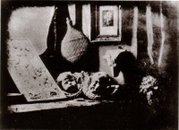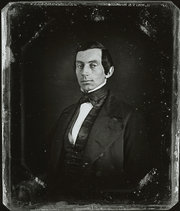|

|
Daguerreotypy spread rapidly, except in England, where Daguerre
had secretly patented his process before selling it to the French
government. The legal problems attending the pursuit of photography
as a profession account in part for the widespread influence of
amateurs (e.g., Nadar, the  French
pioneer photographer) on the early development of the medium.The
popularity of the daguerreotype is attributable to two principal
factors. The first of these was the Victorian passion for novelty
and for the accumulation of material objects, which found its perfect
paradigm in these silvery, exquisitely detailed miniatures. The
second was the greatly increasing demand from a rising middle class
for qualitatively good but, compared to a painter's fee, inexpensive
family portraits. The cheaper tintype eventually made such likenesses
available to all. French
pioneer photographer) on the early development of the medium.The
popularity of the daguerreotype is attributable to two principal
factors. The first of these was the Victorian passion for novelty
and for the accumulation of material objects, which found its perfect
paradigm in these silvery, exquisitely detailed miniatures. The
second was the greatly increasing demand from a rising middle class
for qualitatively good but, compared to a painter's fee, inexpensive
family portraits. The cheaper tintype eventually made such likenesses
available to all.
The principal shortcoming of the daguerreotype and its variants
was inherent in its nature as a direct positive. Unique and unreproducible,
it could not serve for the production of any image intended for
wide distribution. This factor, combined with the lengthy exposure
time necessitated by the process, restricted its function to portraiture.
The vast majority of surviving daguerreotypes are portraits; images
of any other subject are exceedingly rare. Nevertheless, for 20
years the daguerreotype completely overshadowed the greater utility
of the calotype. In the United States, where it was equally popular,
the daguerreotype was promoted by John W. Draper and Samuel F. B.
Morse.
|

